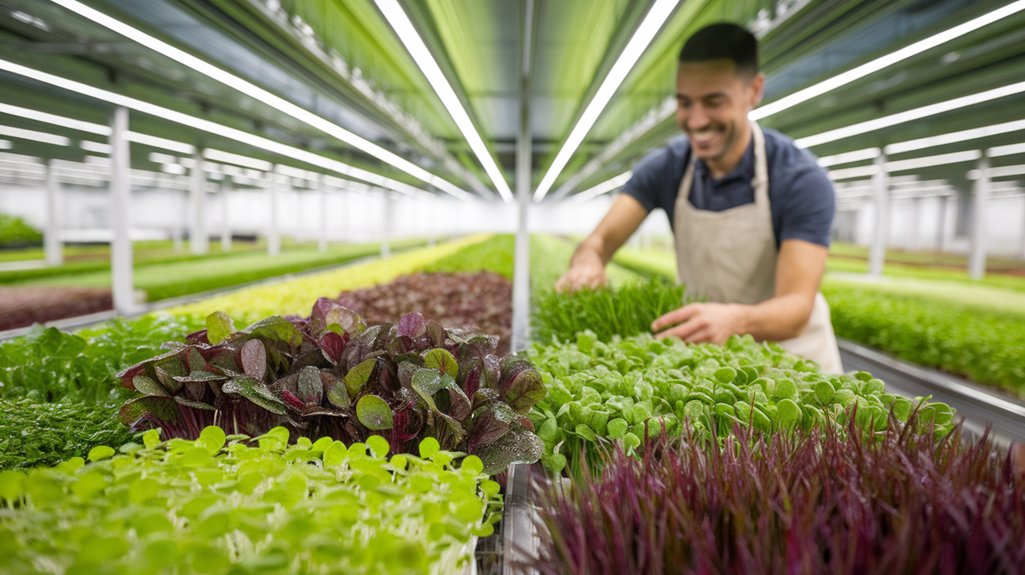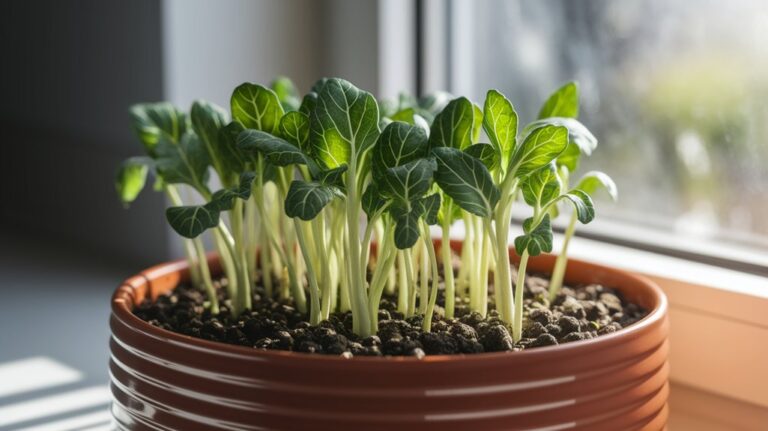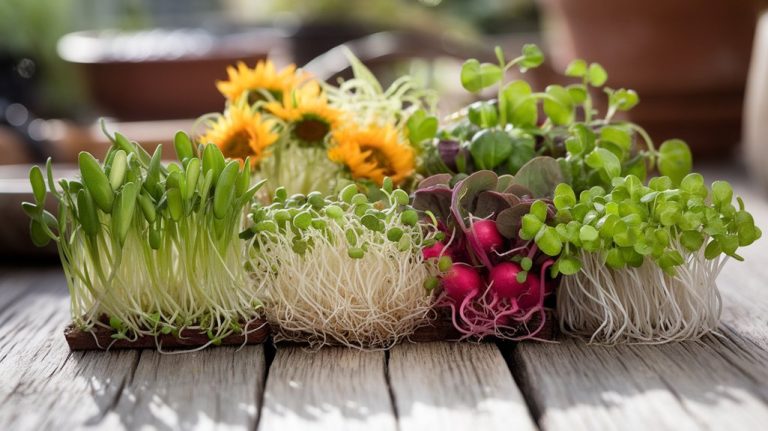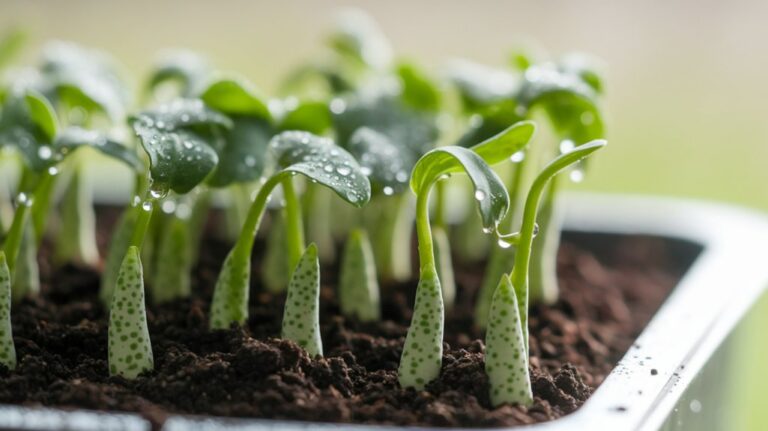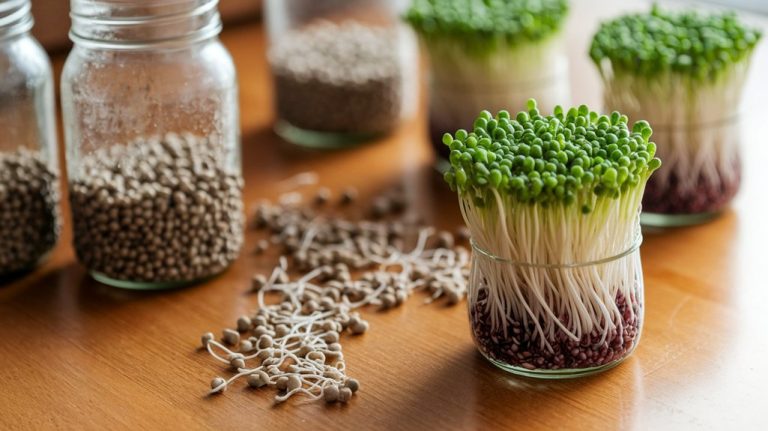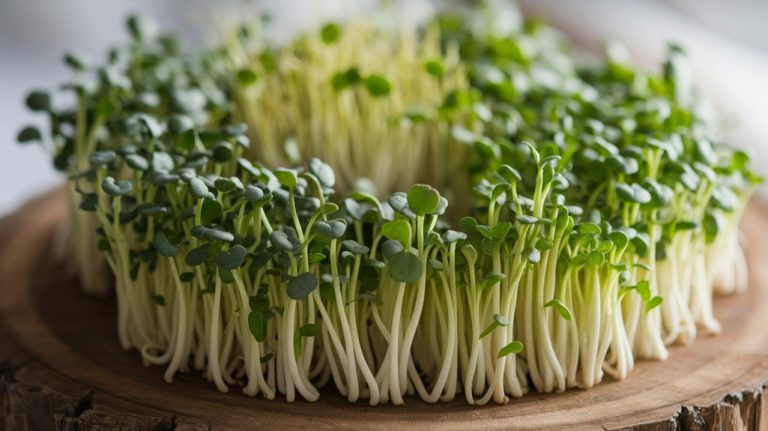Turn Your Passion for Microgreens Into a Thriving Business
Turning my passion for microgreens into a thriving business has been an exciting journey! I discovered the freshness and health benefits of these tiny greens, and now I grow a variety of flavors right in my home. Setting up a compact space and using essential equipment keeps everything organized and efficient. I’ve learned the importance of harvesting well and marketing smartly to engage my local community. There’s so much more to explore in growing your own microgreens business!
Key Takeaways
- Start by researching and selecting popular microgreen varieties that align with your passion and market demand for optimal growth and sales.
- Set up an efficient growing space with proper lighting, ventilation, and organized trays to maximize your production capacity.
- Utilize eco-friendly packaging and engage with local communities through markets and social media to enhance visibility and attract customers.
- Invest in automated systems for growing and harvesting to save time and increase output as your business scales.
- Host workshops and educational events to build customer loyalty and promote sustainable practices while sharing your passion for microgreens.
Understanding Microgreens: Types and Benefits
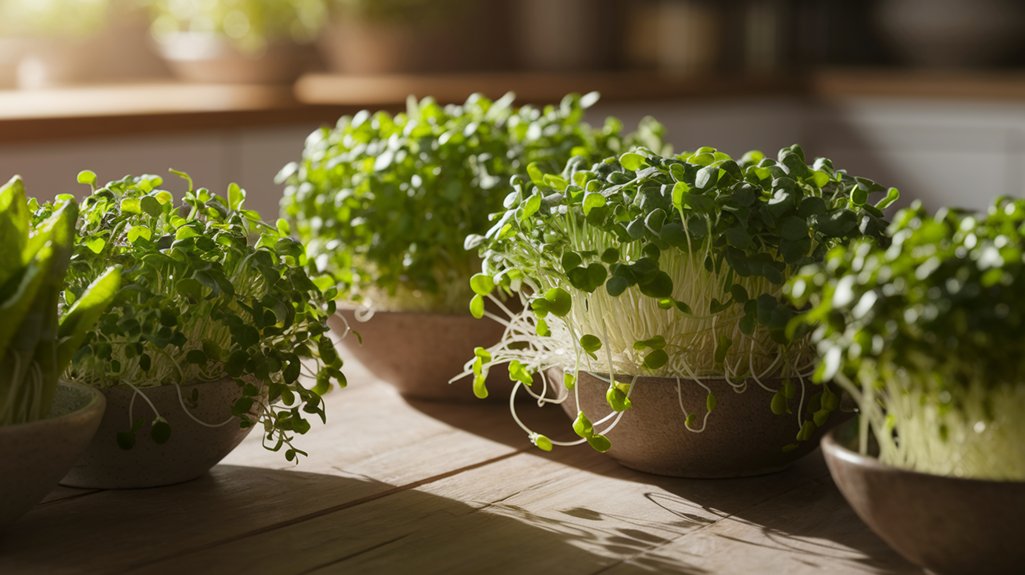
Microgreens are more than just a trendy garnish; they’re a powerhouse of flavor and nutrition packed into tiny leaves. I’ve discovered that these miniature greens, like arugula, radish, and broccoli, not only elevate my dishes but also boost my health.
Each variety offers unique flavors and nutrients, making them a versatile addition to any meal. For instance, basil microgreens bring a fresh, aromatic punch, while sunflower microgreens provide a delightful crunch.
I love how easy they’re to grow, requiring minimal space and time. The best part? They’re packed with vitamins, antioxidants, and essential minerals, making them a superfood in their own right.
Embracing microgreens has transformed my culinary experience, and I can’t wait for you to explore their benefits too!
Setting Up Your Growing Space
After discovering the incredible flavors and health benefits of microgreens, I couldn’t wait to grow my own. Setting up my growing space was the first step in this exciting journey.
I found a bright, well-ventilated area in my home that received ample natural light—this was crucial. I used shelves to maximize vertical space, creating layers of vibrant greens.
I opted for trays that fit my setup perfectly, ensuring efficient use of my limited area. It’s all about organization; keeping everything tidy helps maintain focus and efficiency.
I also made sure to plan for easy access to watering and monitoring. This space became my sanctuary, a place where passion meets productivity, and I can’t wait for you to create your own!
Essential Equipment for Microgreens Cultivation
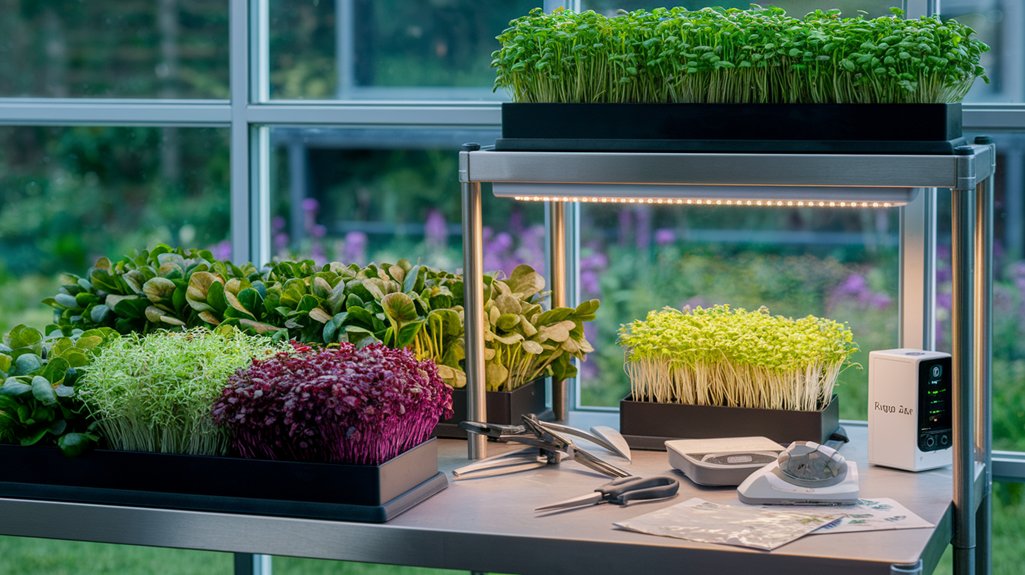
When I started my microgreens journey, I quickly realized that having the right equipment was crucial for success.
From selecting the ideal growing medium to ensuring proper lighting and having the right harvesting tools, each piece makes a difference.
Let’s explore what you need to turn your passion into a thriving business!
Growing Medium Options
Choosing the right growing medium can make all the difference in your microgreens business.
I’ve experimented with various options, and each has its own unique benefits. Coconut coir is my go-to for its excellent moisture retention and sustainability. It keeps the roots happy while allowing for good drainage.
If you’re looking for something more traditional, soil-based mixes can provide essential nutrients, but they might be heavier and messier to manage.
I’ve also tried hydroponic mats, which simplify the process and reduce contamination risks.
Ultimately, it’s about finding what works best for your setup and your plants. Don’t hesitate to test different mediums—your microgreens will thrive, and your business will flourish!
Lighting Requirements
A thriving microgreens business hinges not just on the right growing medium but also on optimal lighting. I can’t emphasize enough how crucial this aspect is.
LED grow lights have become my go-to choice. They’re energy-efficient, provide the full spectrum of light, and can be adjusted to suit different growth stages. I’ve learned to position them about 12-18 inches above my trays to prevent any scorching while ensuring my greens get enough light to flourish.
I also time my lighting—16 hours on, 8 hours off—to mimic natural sunlight cycles. This routine keeps my microgreens vibrant and healthy.
Investing in quality lighting equipment isn’t just a necessity; it’s a commitment to growing the best product possible!
Harvesting Tools Needed
While the right lighting sets the stage for growth, having the proper harvesting tools is equally vital for a successful microgreens business.
I’ve learned that the right tools can make all the difference in efficiency and quality. Here’s what I consider essential:
- Sharp Scissors or Shears – Precision cutting ensures clean edges and promotes freshness.
- Harvesting Tray – A sturdy tray holds your microgreens without damaging them during transport.
- Spray Bottle – Keeps your greens hydrated without over-saturating the soil.
- Scale – For accurate measuring, ensuring consistent portion sizes for customers.
Investing in these tools not only enhances your harvesting process but also reflects your dedication to quality, making your microgreens truly stand out in the market.
Cultivation Techniques for Beginners
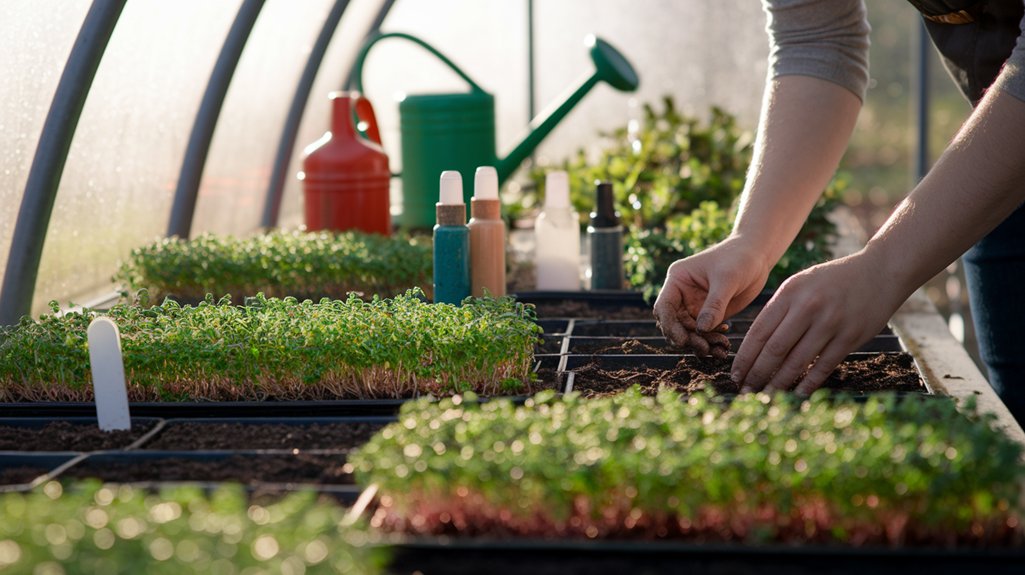
Diving into the world of microgreens can be an exciting adventure, and I can assure you that even beginners can thrive with the right techniques.
Start by selecting easy-to-grow seeds like radish, basil, or sunflower. Use shallow trays filled with quality potting mix, ensuring good drainage. Water them gently to avoid over-saturation; I prefer using a spray bottle for precision.
Position your trays in a bright area or under grow lights for about 12-16 hours daily. Keep the temperature around 70°F for optimal growth.
Remember to occasionally check for mold and adjust airflow as needed. With patience and care, you’ll witness those tiny seeds transform into vibrant greens ready to impress your customers!
Happy cultivating!
Harvesting and Packaging Your Microgreens
After nurturing your microgreens to their vibrant peak, it’s time to focus on harvesting and packaging them for sale. This step can set you apart in the market, so here’s how I do it:
- Use Sharp Scissors: Snip the microgreens just above the soil line to ensure a clean cut and promote regrowth.
- Harvest in the Morning: The flavor’s at its peak, and the leaves are crisp and full of moisture.
- Rinse and Dry: Gently rinse the greens in cool water, then pat them dry with a clean towel or use a salad spinner.
- Select Eco-Friendly Packaging: Consider compostable containers or recyclable clamshells to appeal to eco-conscious customers.
With these steps, your microgreens won’t only look great but also attract customers eager to enjoy your fresh produce!
Marketing Your Microgreens Business
To successfully market my microgreens business, I focus on connecting with my local community and showcasing the unique benefits of my produce.
I use social media to share vibrant photos and engaging stories about my microgreens, highlighting their nutritional value and versatility in meals.
Farmers’ markets become my stage, where I interact directly with customers, offering samples to spark interest.
I create informative flyers that explain the health benefits and culinary uses of each variety.
Collaborating with local wellness events lets me reach health-conscious consumers.
By sharing recipes and tips through a blog, I keep my audience engaged and informed.
This approach not only builds brand loyalty but also fosters a community that values fresh, sustainable food.
Building Relationships With Local Restaurants and Markets
Connecting with local restaurants and markets has been a game changer for my microgreens business. Building these relationships not only boosts my sales but also enhances my credibility in the community.
Here’s how I approach it:
- Visit in Person: Nothing beats face-to-face interaction. I bring samples and let chefs taste my microgreens.
- Listen to Their Needs: Understanding their menu and preferences allows me to tailor my offerings.
- Offer Consistent Quality: I ensure my microgreens are fresh and high-quality every time.
- Follow Up: After our initial meeting, I check in regularly to maintain the connection and adapt to any changes.
These strategies have helped me establish strong partnerships and grow my passion into a thriving venture.
Scaling Your Microgreens Business for Growth
As I dive deeper into my microgreens business, scaling for growth becomes essential to reaching new markets and maximizing my impact. I’ve found that investing in efficient systems—like automated growing and harvesting—saves me time and increases output.
Partnering with local distributors also expands my reach, allowing me to tap into farmers’ markets and grocery stores. I’m passionate about educating my customers, so hosting workshops and tutorials not only builds community but also boosts sales.
Social media’s a game-changer, too; showcasing my vibrant products attracts attention and drives demand. By focusing on sustainability and quality, I’m not just growing microgreens—I’m cultivating a brand that resonates with health-conscious consumers.
Scaling might be challenging, but it’s immensely rewarding.
Frequently Asked Questions
How Much Space Do I Need to Grow Microgreens?
When I started growing microgreens, I realized you don’t need much space at all! A small countertop or a shelf in your kitchen can work wonders.
I typically use trays measuring 10 by 20 inches, and with just a few of those, I can produce a bounty of greens.
In fact, even a sunny windowsill is enough to kick off your microgreens journey. It’s all about maximizing what you have and getting creative!
What Are the Best Microgreens for Beginners?
When I started growing microgreens, I found that some varieties are perfect for beginners. I love starting with radish, broccoli, and pea shoots.
They’re easy to grow, germinate quickly, and taste fantastic! I remember the excitement of seeing those tiny greens sprout in just a few days.
Plus, they’re versatile in the kitchen. If you’re just diving in, these microgreens will set you up for success and keep you motivated!
How Long Does It Take to Grow Microgreens?
Growing microgreens usually takes about 7 to 21 days, depending on the variety.
I’ve found that faster-growing options like radish or mustard can be ready in just a week! I love checking on them daily as they sprout; it’s truly rewarding.
Just make sure you provide enough light and moisture. Once they reach a couple of inches tall, it’s time to harvest.
Trust me, the wait is worth it for those fresh flavors!
Can I Grow Microgreens Indoors Year-Round?
Absolutely, you can grow microgreens indoors year-round! I’ve done it myself, and it’s incredibly rewarding.
Just make sure you have a well-lit space, or use grow lights to ensure they get enough light. I’ve found that keeping the temperature between 65-75°F works best.
With a little care, you can enjoy fresh, nutritious microgreens no matter the season. It’s a fun and simple way to bring a bit of green into your home!
What Are Common Pests or Diseases in Microgreens?
I’ve encountered a few common pests and diseases while growing microgreens.
Aphids and fungus gnats can sneak in, munching on your greens or laying eggs in the soil.
I’ve also seen damping-off disease, which can wipe out seedlings if conditions are too damp.
To combat these issues, I keep my growing area clean, monitor moisture levels, and sometimes use beneficial insects.
Staying vigilant makes all the difference in maintaining healthy microgreens!
Conclusion
Turning your passion for microgreens into a thriving business isn’t just a dream—it’s a journey filled with creativity and growth. By understanding the nuances of cultivation, mastering marketing, and building strong relationships, you can watch your venture flourish. Embrace the challenges, celebrate your successes, and don’t forget to savor the incredible flavors your greens bring to the table. With dedication and a sprinkle of innovation, you can transform your love for microgreens into a rewarding enterprise.

